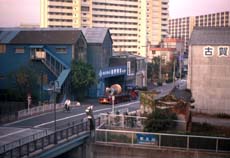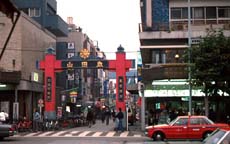The city in flux
In the War many Japanese cities lost all their old forms, but they were rapidly filled with groups of buildings that, from the very outset, looked like ruins with no visual order. Steel and concrete covered with advertisements, neon lights and telegraph poles came in and passed out of existence easily. Cities lost their monumentality behind an aggregation of flickering, lightweight and superficial elements. They began to convey their meanings to us through semiotic codes rather than actual solid forms. The development of various kinds of new media intensified this trend.
The city is undeniably in a state of flux. Invisible, it is virtually simulated by the codes that fill it. . . . I foresaw a city filled with unreal codes where the interpretation of the classical structure of cognition is meaningless. I now believe that design and city planning will become impossible using methods which involve only the manipulation of physical actualities. Since coming to this conclusion, although I regard cities as fit objects for consideration, I have ceased to think that they can be designed and hence, no longer undertake work of that kind. Isozaki 1996, 30-1

